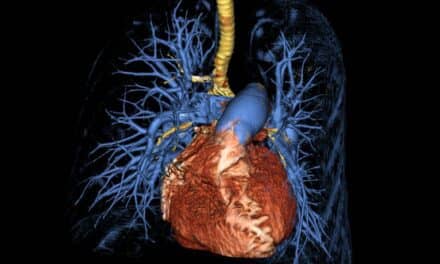Patients with pulmonary arterial hypertension (PAH) had approximately double the reduction in pulmonary vascular resistance (PVR) if they took the PAH medications macitentan (10 mg) and tadalafil (40 mg) together in a single tablet rather than either drug alone, according to research being presented at the American College of Cardiology’s Annual Scientific Session Together With the World Congress of Cardiology.
Macitentan and tadalafil are among several drugs approved by the US Food and Drug Administration for the treatment of PAH. Guidelines and previous studies suggest that using two or more agents to treat PAH can bring extra benefits, but the new trial directly compares the use of a fixed-dose combination of these drugs in a single tablet versus either medication by itself.
In the portion of the study that compared the fixed-dose combination with macitentan monotherapy, PVR decreased by 45% in the fixed-dose combination arm and by 23% in the monotherapy arm. In a comparison with tadalafil monotherapy, PVR decreased by 44% in the fixed-dose combination arm and 22% in the monotherapy arm.
“We were very happy with the results,” says Kelly Chin, MD, professor of medicine and director of the pulmonary hypertension program at UT Southwestern Medical Center in Dallas and the study’s lead author, in a press release. “PVR fell in both patients who were on one therapy and patients who were on two, but it was a much larger decrease with fixed-dose combination therapy.”
The researchers enrolled 187 patients with PAH who experienced limitations in physical activity due to the condition but were comfortable at rest. Most of the patients were women, and the average age ranged from 49 to 53 years in the treatment groups. This reflects a typical patient population for PAH, which is most common in women between 30 and 60 years.
About half of the study participants were not yet taking any medications for PAH. The researchers randomly assigned half of these patients to take a two-drug combination pill containing 10 mg of macitentan and 40 mg of tadalafil daily. One-quarter were assigned to take either macitentan or tadalafil but not their combination in a tablet. Of patients who were already taking macitentan or tadalafil at the start of the study, researchers assigned two-thirds to receive the two-drug combination tablet and one-third to continue taking the drug they were already taking.
At week 16, participants taking the two-drug combination tablet showed a significantly greater reduction in PVR compared to baseline than participants taking either drug alone, meeting the trial’s primary endpoint. Although the study could not draw any clear conclusions on symptoms or cardiovascular outcomes, researchers said the findings bolster the evidence that multiple drugs provide added benefits for PAH management compared to just one.
“Across many studies, we’re seeing that more is better in terms of lowering PVR, and what we get with one medication is, for many patients, just not enough,” says Chin in a press release. “I would strongly recommend combination therapy with two medications initially for the majority of patients, and this combination has significant evidence that it’s effective and well tolerated.”
Patients taking the two-drug combination therapy were more likely to discontinue their assigned therapy due to adverse events, with anemia, hypotension, and swelling being the most common side effects. It is typical for people taking two drugs to experience more side effects than people taking one, and the study did not find evidence of any side effects that were previously unknown.
Chin says a fixed-dose combination pill could be more convenient for patients than two medications taken separately, potentially increasing medication adherence. However, the study did not compare the use of a combination pill to combination therapy in which the two drugs were taken separately.
The study was funded by Actelion Pharmaceuticals Ltd, a Janssen Pharmaceutical Company of Johnson & Johnson.










